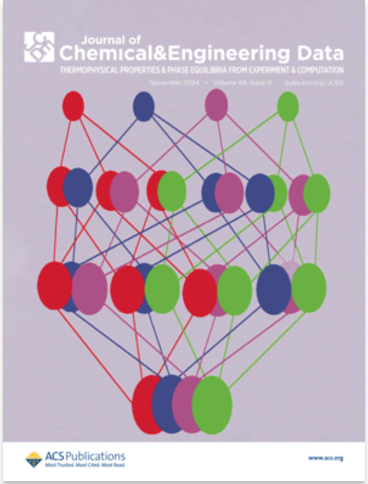在高温下用甲基异丁基酮从水溶液中分离丁酸并引入生物缓冲剂(EPPS/MOPS)
IF 2.1
3区 工程技术
Q3 CHEMISTRY, MULTIDISCIPLINARY
引用次数: 0
摘要
从水溶液中分离和提纯丁酸的应用非常广泛。液-液萃取是一种分离低浓度溶质水溶液混合物的高效技术。本研究旨在使用两种生物缓冲液从水溶液中分离丁酸:4-(2-hydroxyethyl)-1-piperazine-propanesulfonic acid (EPPS) 和 3-(N)-morpholino-propanesulfonic acid (MOPS)。甲基异丁基酮(MIBK)用作丁酸分离的萃取溶剂。水-丁酸-MIBK-EPPS 和水-丁酸-MIBK-MOPS 系统的四元液-液平衡(LLE)数据是在常压(P = 0.1 MPa)条件下测定的,温度分别为 313.15 和 323.15 K。通过计算 LLE 连接线数据中的分布系数和分离因子,对萃取性能进行了评估。在高温条件下,研究了两种不同缓冲剂对 LLE 的影响。在这项研究中,通过σ-profiles分析评估了所研究化合物之间的分子相互作用。通用准化学模型(UNIQUAC)、非随机双液模型(NRTL)和段活性系数的导体样筛选模型(COSMO-SAC)与 LLE 实验数据一致。在设计萃取器时,需要使用改进的分离程序获得的改进的二元相互作用参数。本文章由计算机程序翻译,如有差异,请以英文原文为准。

Separation of Butyric Acid from Aqueous Solution by Methyl Isobutyl Ketone with the Introduction of Biological Buffer (EPPS/MOPS) at Elevated Temperatures
The separation and purification of butyric acid from an aqueous solution is of great importance in wide applications. Liquid–liquid extraction is a highly effective technique for the separation of an aqueous mixture with a low concentration of solute. The aim of this study was to isolate butyric acid from an aqueous solution using two biological buffers: 4-(2-hydroxyethyl)-1-piperazine-propanesulfonic acid (EPPS) and 3-(N)-morpholino-propanesulfonic acid (MOPS). Methyl isobutyl ketone (MIBK) was used as an extraction solvent for butyric acid separation. The quaternary liquid–liquid equilibrium (LLE) data for the water-butyric acid-MIBK-EPPS and water-butyric acid-MIBK-MOPS systems were determined under atmospheric pressure (P = 0.1 MPa) at 313.15 and 323.15 K, respectively. The extraction performance was evaluated by calculating the distribution coefficient and the separation factor from the LLE tie lines data. The influence of two types of different buffers on the LLE was studied at elevated temperatures. In this study, the molecule interactions among compounds investigated were assessed by σ-profiles analysis. The universal quasi-chemical (UNIQUAC), the nonrandom two-liquid (NRTL), and the conductor-like screening model for the segment activity coefficient (COSMO-SAC) were able to agree with the experimental LLE data. For the design of the extractor, the improved binary interaction parameters obtained by the improved separation procedure were required.
求助全文
通过发布文献求助,成功后即可免费获取论文全文。
去求助
来源期刊

Journal of Chemical & Engineering Data
工程技术-工程:化工
CiteScore
5.20
自引率
19.20%
发文量
324
审稿时长
2.2 months
期刊介绍:
The Journal of Chemical & Engineering Data is a monthly journal devoted to the publication of data obtained from both experiment and computation, which are viewed as complementary. It is the only American Chemical Society journal primarily concerned with articles containing data on the phase behavior and the physical, thermodynamic, and transport properties of well-defined materials, including complex mixtures of known compositions. While environmental and biological samples are of interest, their compositions must be known and reproducible. As a result, adsorption on natural product materials does not generally fit within the scope of Journal of Chemical & Engineering Data.
 求助内容:
求助内容: 应助结果提醒方式:
应助结果提醒方式:


